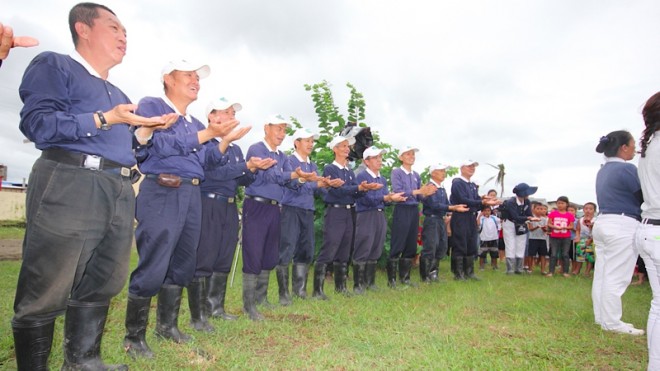‘Symbol of hope’ for ‘Yolanda’ survivors rising

The blue-and-white clad volunteers of Tzu Chi Foundation say a prayer before doing their daily activities in Palo, Leyte, on Jan. 21, 2014. The world’s biggest Buddhist charity has started the construction of 2,000 plastic houses for families displaced by the Super Typhoon “Yolanda.” PHOTO BY DANNY PETILLA
ORMOC CITY, Philippines—A new “symbol of hope” for survivors of Super Typhoon “Yolanda” is fast-rising in this city, which was sent to its knees when storm surges and powerful winds of biblical proportions barreled through the Visayas region a year ago.
Tzu Chi Foundation, the world’s biggest Buddhist charity, has started the construction of 2,000 plastic houses for families displaced by the
typhoon—internationally known as “Haiyan.”
“This is a symbol of hope for typhoon survivors in Leyte,” Alfred Li, the foundation’s chief executive officer, told reporters on Saturday.
“Our founder said we should help take care of the body (of the typhoon survivors). The construction of these houses is for that purpose,” he said.
Li said the P500-million housing program was the biggest charity project of his group, which first caught the attention of the public when it sponsored a cash-for-work program in Tacloban City and nearby towns in Leyte province a few days after Yolanda struck on Nov. 8, 2013.
After attending the commemoration of Yolanda’s first anniversary, Interior Secretary Mar Roxas and Presidential Assistant for Reconstruction and Rehabilitation Panfilo Lacson led the inspection of the ingenious shelter program in a 50-hectare property in Barangay (village) Liloan.
Dignity
Li said the land was donated by the family of Mayor Edward Codilla.
“More than the value of these shelters, I think the more important thing is the sense of dignity that these structures give the survivors,” Roxas said.
“They will now have a place of their own which offers privacy. Besides dignity, these houses will also give them a sense of safety,” he added.
Each of the 27-square-meter structures costs P100,000, Li said. Its roofing and walls are made of beige-colored polypropylene, a type of hard plastic, joined together by steel metals.
Each unit has three bedrooms, a small kitchen, a living room and a “self-contained” toilet. It also has a “skylight panel” that allows ventilation.
Like camping tents, the four corners of the houses will be tied down to the concrete floor with steel cables, allowing them to withstand winds of up to 175 kilometers per hour.
Besides screen windows, tiled floors make the houses more decent than the temporary bunkhouses that the government has built for the survivors.
Site at ground zero
Since the project began last month, Li said 50 houses had been completed. The charity intends to build at least 500 houses more by December, he said.
Li said the foundation was planning to construct 2,000 houses in Ormoc and another 300 in Palo town, also in Leyte.
He said his group was discussing with the officials of Tacloban City a possible site in the area known as ground zero for the deadly cyclone.
“While we are Buddhists, we hope to finish this as a Christmas gift to the people,” Li said.
Cost-efficient
Li said the shelters were cost-efficient since each house required only 10 people to assemble. With proper training, he said a 10-member construction team could finish a house in just one day.
“We are now training 20 to 30 groups to help us build the houses. All the materials, which were imported from the United States, are already here and are ready to be assembled,” he said. “In time, this place will be a new barangay.”
Roxas said the government may replicate Tzu Chi’s unique housing program in other typhoon-stricken areas.
“This is a product of Tzu Chi’s best practices. They have developed their own design. I think we can learn something from their engineering experience,” Roxas said.
RELATED STORIES
Tacloban folk get work from Taiwan foundation
Tacloban rising from the rubble














